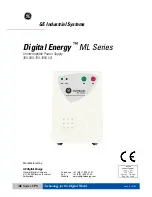
Capstone Turbine Corporation
Model C65 Hybrid UPS User’s Manual
400027 Rev A (July 2010)
Page
53 of 66
Capstone reserves the right to change or modify, without notice, the design, specifications, and/or contents of this document without
incurring any obligation either with respect to equipment previously sold or in the process of construction.
Using a PC with CRMS
Capstone Remote Monitoring Software (CRMS) is available in a User Edition to view data
and to provide customers limited control of Hybrid UPS Systems. The software includes
minimum PC requirements for proper operation. The CRMS User Manual is embedded in
the software help function, and provides intuitive interaction to read data, issue setup and
control commands, and view fault history. Once loaded onto a customer PC, CRMS can
be connected to a Hybrid UPS system is several ways:
•
Through the UPS Controller – the UPS Controller includes industry standard
10BaseT Ethernet ports for connection to a PC. Plugging into one of these ports
allows the CRMS software to view each Hybrid UPS system connected to the UPS
Controller. The PC can be a laptop that is temporarily connected, or can be any PC
on a network that is connected to the UPS Controller’s Ethernet Port. Refer to the
UPS Controller User Manual (400028) for the location of these Ethernet
connections.
•
Through the Serial-to-Ethernet Converter in the Hybrid UPS System – each Hybrid
UPS system includes a dual port serial-to-Ethernet converter that connects to both
the DB9 RS-232 User Interface Port and the DB25 RS-232 Maintenance Interface
Ports in the Communications Bay on the back of the MicroTurbine. The serial-to-
Ethernet converter uses the Maintenance Port for CRMS connectivity.
Connecting Directly to a Hybrid UPS System
The figures below shows the location of the JUCB communications board within the
Communications Bay at the rear of a Hybrid UPS system, and where the Serial-to-
Ethernet converter is mounted within the Communciations Bay.
WARNING
The User should NOT open the Power Connection Bay within the User
Connection Bay (UCB). Potentially lethal voltages exist inside the
Power Connection Bay.
Figure 8 shows the User Interface Port location.














































